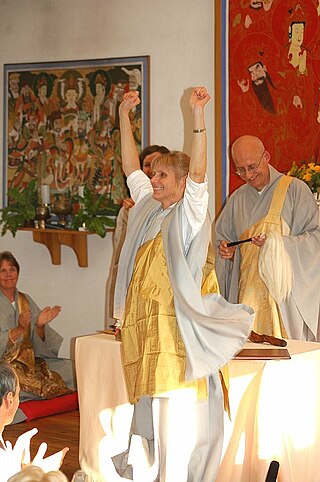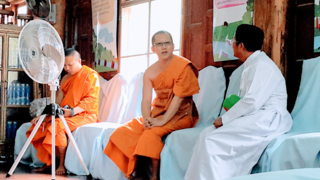Related Research Articles

Religion in Japan is manifested primarily in Shinto and in Buddhism, the two main faiths, which Japanese people often practice simultaneously. According to estimates, as many as 80% of the populace follow Shinto rituals to some degree, worshiping ancestors and spirits at domestic altars and public shrines. An almost equally high number is reported as Buddhist. Syncretic combinations of both, known generally as shinbutsu-shūgō, are common; they represented Japan's dominant religion before the rise of State Shinto in the 19th century.

Chinese Buddhism or Han Buddhism is a Chinese form of Mahayana Buddhism which draws on the Chinese Buddhist canon as well as numerous Chinese traditions. Chinese Buddhism focuses on studying Mahayana sutras and Mahāyāna treatises and draws its main doctrines from these sources. Some of the most important scriptures in Chinese Buddhism include: Lotus Sutra, Flower Ornament Sutra, Vimalakirtī Sutra, Nirvana Sutra, and Amitābha Sutra. Chinese Buddhism is the largest institutionalized religion in mainland China. Currently, there are an estimated 185 to 250 million Chinese Buddhists in the People's Republic of China. It is also a major religion in Taiwan, Singapore, and Malaysia, as well as among the Chinese Diaspora.

State atheism or atheist state is the incorporation of hard atheism or non-theism into political regimes. It is considered the opposite of theocracy and may also refer to large-scale secularization attempts by governments. To some extent, it is a religion-state relationship that is usually ideologically linked to irreligion and the promotion of irreligion or atheism. State atheism may refer to a government's promotion of anti-clericalism, which opposes religious institutional power and influence in all aspects of public and political life, including the involvement of religion in the everyday life of the citizen. In some instances, religious symbols and public practices that were once held by religions were replaced with secularized versions of them. State atheism in these cases is considered as not being politically neutral toward religion, and therefore it is often considered non-secular.
The history of Buddhism can be traced back to the 5th century BCE. Buddhism arose in Ancient India, in and around the ancient Kingdom of Magadha, and is based on the teachings of the renunciate Siddhārtha Gautama. The religion evolved as it spread from the northeastern region of the Indian subcontinent throughout Central, East, and Southeast Asia. At one time or another, it influenced most of Asia.

This list of Buddhism by country shows the distribution of the Buddhist religion, practiced by about 535 million people as of the 2010s, representing 7% to 8% of the world's total population. It also includes other entities such as some territories.

Buddhism is a minority religion in Argentina, where, in addition to the majority of the Christian population, the rate of self-professed Buddhists is about 0.5%.

Buddhism is the third largest religion in France, after Christianity and Islam.
The Lay Buddhist Ordination (Chinese: 受戒; pinyin: shòujiè, Japanese: Jukai, Korean: sugye refers to the public ordination ceremony wherein a lay follower of Zen Buddhism receives certain Buddhist precepts. The particulars of the ceremony differ widely by country and by school of Buddhism.
There are no known official statistics of religions in North Korea. Officially, North Korea is an atheist state, although its constitution guarantees free exercise of religion, provided that religious practice does not introduce foreign forces, harm the state, or harm the existing social order. Based on estimates from the late 1990s and the 2000s, North Korea is mostly irreligious, with the main religions being Shamanism and Chondoism. There are small communities of Buddhists and Christians. Chondoism is represented in politics by the Party of the Young Friends of the Heavenly Way, and is regarded by the government as Korea's "national religion" because of its identity as a minjung (popular) and "revolutionary anti-imperialist" movement.

The majority of Vietnamese do not follow any organized religion, instead participating in one or more practices of folk religions, such as venerating ancestors, or praying to deities, especially during Tết and other festivals. Folk religions were founded on endemic cultural beliefs that were historically affected by Confucianism and Taoism from ancient China, as well as by various strands of Buddhism. These three teachings or tam giáo were later joined by Christianity which has become a significant presence. Vietnam is also home of two indigenous religions: syncretic Caodaism and quasi-Buddhist Hoahaoism.
Asia is the largest and most populous continent and the birthplace of many religions including Buddhism, Christianity, Confucianism, Hinduism, Islam, Jainism, Judaism, Shinto, Sikhism, Taoism, and Zoroastrianism. All major religious traditions are practiced in the region and new forms are constantly emerging. Asia is noted for its diversity of culture. Islam is the largest religion in Asia with approximately 1.3 billion adherents.

With a rough estimate of 6100 Buddhists, Buddhism is practiced by around 0.05% of the Czech population. The World Buddhist Directory lists 70 Buddhist places in the Czech Republic.
It is estimated that in the Middle East, over 900,000 people profess Buddhism as their religion. Buddhist adherents make up just over 0.3% of the Middle East total population. Many of these Buddhists are workers who have migrated from other parts of Asia to the Middle East since the late 1990s, many of them come from countries that have large Buddhist populations, such as China, Vietnam, Thailand, Sri Lanka, and Nepal.

Buddhism in Central Asia mainly existed in Mahayana forms and was historically especially prevalent along the Silk Road. The history of Buddhism in Central Asia is closely related to the Silk Road transmission of Buddhism during the first millennium of the common era.
Bhutan is a Buddhist country by constitution and Buddhism plays a vital role in the country.

Buddhism is the third largest religion in Brunei, after the majority state religion of Islam, and the slightly larger minority religion Christianity. Estimates vary, but some reports place the number of Buddhists in Brunei around 30,000, and the estimated percentage of Buddhists in Brunei around 7-8% of the total population. According to Brunei's official 2016 data, 7% (29,495) of the population practices Buddhism.
Myanmar (Burma) is a Buddhist majority country with a significant minority of Christians and other groups residing in the country.

According to the 2018 census, Buddhism is the largest religion in Thailand, practiced by over 94% of the population; Islam makes up 5% of the population. The Thai government officially recognizes five religions: Buddhism, Islam, Hinduism, Sikhism, and Christianity.

Buddhism is practised in Africa. Though there have been some conversions amongst Africans, the majority of Buddhists in Africa are of Asian descent, mostly Chinese, Vietnamese, Sri Lankan or Japanese.

Religion in South Korea is diverse. Most South Koreans have no religion. Christianity and Buddhism are the dominant confessions among those who affiliate with a formal religion. Buddhism, which arrived in Korea in 372 AD, has thousands of temples built across the country.
References
- Country Profile of Libya (Religious Intelligence)
- Religious Freedom Profile of Libya [1]
- The US State Department's International Religious Freedom Report 2006 - Libya [2]
- ↑ Religious Freedom Page Archived November 6, 2007, at the Wayback Machine
- ↑ "Libya". Archived from the original on 2020-05-18. Retrieved 2019-05-26.